Looking for some fascinating creatures to add to your spider repertoire? Look no further than the world of black and yellow spiders!
These brash and stunning arachnids are among the most captivating and eye-catching animals in the natural world. Here’s a preview:

There are numerous species to research and learn about, ranging from the well-known black and yellow garden spider to the less well-known yellow-backed spiny spider. So let’s explore the fascinating world of black and yellow spiders and learn what makes these animals so exceptional.
1. Golden Orb-Weaver Spider
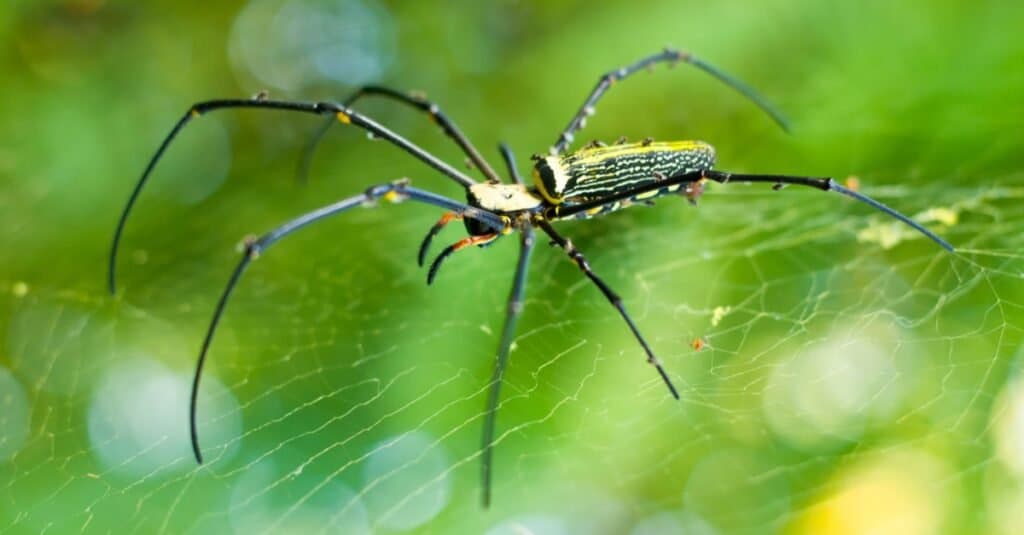
On essentially all landmasses warm enough to host them, you may find golden orb-weaver spiders.
©makuromi/Shutterstock.com
The golden orb-weaver spider is found worldwide in tropical and subtropical regions. It’s on practically every landmass that’s warm enough to host them.
These spiders are best known for their golden-colored thread, which they use to construct large, orb-shaped webs. These can span several feet in diameter and are extremely strong. Smaller spiders and insects may use them as a form of shelter.
The males and females of this species are different. Females can grow up to 5 inches, while males are much smaller and more brownish than black.
On the other hand, females are bright yellow-orange with black stripes on their legs and abdomen. Their underside is often black or brown.
While this spider may look scary, it isn’t dangerous to humans. It feeds mostly on insects that it catches in its web.
2. Black and Yellow Garden Spider

The black and yellow garden spider is a common sight throughout much of the United States.
©iStock.com/AwakenedEye
The common and distinctive black and yellow garden spider (Argiope aurantia), commonly called the yellow garden spider, is widespread in much of the United States and Canada.
This spider is famous for large, orb-shaped webs measuring up to 2 feet (60 cm) in diameter. The web is typically built in a sunny area, such as a garden or meadow, to catch flying insects like flies, bees, and wasps.
The sexual dimorphism of the black and yellow garden spider results in substantial morphological differences between males and females. Males are normally much smaller and have a more slender body structure, while females can grow up to 1.5 inches (4 cm) in length.
The black and yellow garden spider gets its name from the distinctive black and yellow markings on its abdomen that mimic those on a wasp. The spider’s legs often have black stripes and are yellow or orange in hue. The spider typically has a pale or silvery tint on its underbelly.
Like most spiders, the black and yellow garden spider is not considered harmful to people and helps reduce nuisance insect populations. The spider may bite if startled, but the venom won’t hurt people and typically only results in minor localized pain and swelling.
3. Yellow Sac Spider

Common to North America, Europe, and Asia, you can find yellow sac spiders throughout the world.
©Rainer Fuhrmann/Shutterstock.com
The yellow sac spider (Cheiracanthium inclusum) is a common spider species in many parts of the world, including North America, Europe, and Asia. It is a tiny spider, measuring only 1/4 to 3/8 inches (6 to 10 mm).
The yellow sac spider gets its name from creating sac-like webs, typically in plants, shrubs, or corners of buildings, as suggested by its name. They often have long, slender legs and are tan, yellow, or pale in color.
The yellow sac spider is a nocturnal predator that preys mostly on ants, flies, and other spiders. They chase their food on foot rather than spinning enormous webs as other spider species do.
Yellow sac spiders are well known in medicine since they occasionally bite people and leave behind mild to moderate symptoms. Localized pain, redness, and swelling may result from the bite, and more severe symptoms like nausea, headaches, and muscle discomfort occasionally. In rare instances, those with medical issues may react to the bite more severely.
4. Banded Garden Spider
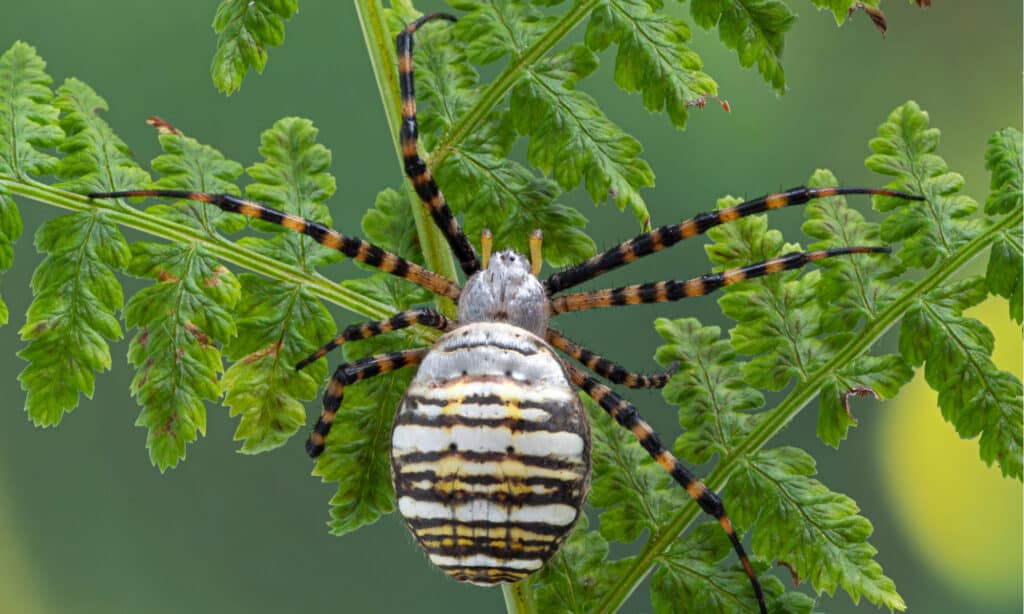
Banded garden spiders call North America, South America,
Africa
, and Asia home.
©Ernie Cooper/Shutterstock.com
The banded garden spider (Argiope trifasciata) is a species of orb-weaving spider found worldwide, including in North and South America, Africa, and Asia. It is a medium-sized spider with much smaller males and females reaching lengths up to 1.5 inches (3.8 cm).
The banded garden spider’s abdomen’s black and yellow banded pattern resembles that of the black and yellow garden spider but has thinner bands. These bands gave the species its name. The spider’s legs and cephalothorax, which contrast with its vibrant abdomen, are white or gray.
Like other orb-weaving spiders, the banded garden spider weaves orbs that can reach several feet in diameter. Usually constructed in sunny areas like gardens or meadows, these webs trap flying insects, including flies, bees, and wasps.
The banded garden spider is not known to be hostile, and its bite is not considered hazardous to people. Instead of biting if startled, the spider may retreat or drop from its web.
5. Northern Yellow Sac Spiders
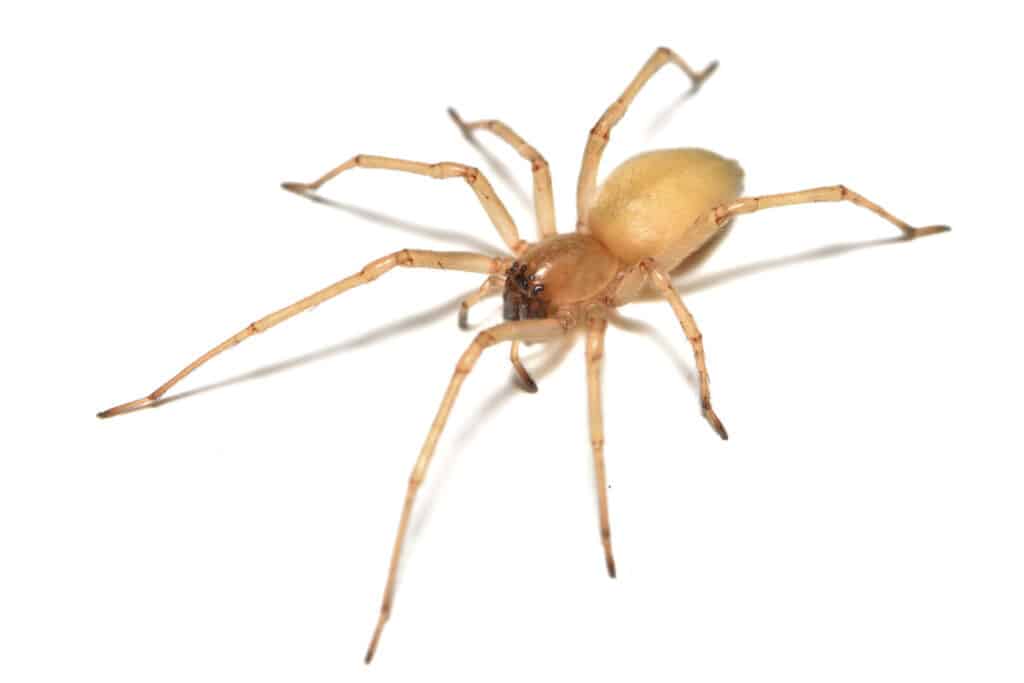
The bite of a yellow sac spider may cause pain, redness, and swelling in humans. Beyond that, though, it isn’t dangerous.
©Tobias Hauke/Shutterstock.com
The northern yellow sac spider (Cheiracanthium mildei) is a small spider that commonly inhabits many parts of the world, including North America, Europe, and Asia. Additionally, these spiders tend to be attracted to warm and dry areas, such as attics, basements, and wall voids, and are often found indoors.
The northern yellow sac spider is a hunter and actively pursues its prey, relying on speed and agility instead of webs to catch small insects like flies, mosquitoes, and other spiders.
These spiders usually build small tube-like webs in sheltered areas, such as corners of buildings, under rocks, or inside plant foliage. Although the northern yellow sac spider’s bite is not usually dangerous, it can cause pain, redness, and swelling at the bite site.
In rare cases, some individuals may experience more severe symptoms, such as nausea, headache, or muscle pain. It’s important to note that these spiders are not aggressive and typically only bite humans if they feel threatened or cornered.
6. Orchard Orb-Weaver Spider

Orchard orb-weaver spiders are common in orchards and gardens in North and South America.
©Karthik Nayak Virajpet/Shutterstock.com
The orchard orb-weaver spider (Leucauge venusta) is a colorful and unique species of spider commonly found in orchards and gardens throughout North and South America. These spiders are known for their distinctive silver, yellow, and brown markings, which give them a striking appearance. Orchard orb-weaver spiders are active hunters often found hanging upside down in their webs, waiting for prey to approach.
One of the interesting features of the orchard orb-weaver spider is that they spin two types of webs. The first type is a non-sticky web used as a platform for the spider to rest on or move around. The second type is a sticky web used to capture prey. The spider typically builds the sticky web in a spiral shape, starting at the center and moving outward. The spider will then wait patiently in the center of the web for prey to become ensnared.
Orchard orb-weaver spiders are typically active during the daytime and are known for their ability to move quickly and jump from branch to branch.
Also, they have a reputation for being ferocious defenders of their webs against other spiders and predators.
Although the orchard orb-weaver spider is not considered dangerous to people, its venom can produce moderate swelling and discomfort where it bites. They are also known to be helpful to gardens and orchards because they reduce populations of pests like flies and aphids.
It is advised to establish a range of flowering plants and to offer lots of protection and hiding places if you want to attract orb-weaver spiders to your garden or orchard. Also, since pesticides and insecticides can kill spiders and other beneficial insects, avoiding applying them is crucial.
7. Yellow-Backed Spiny Spider
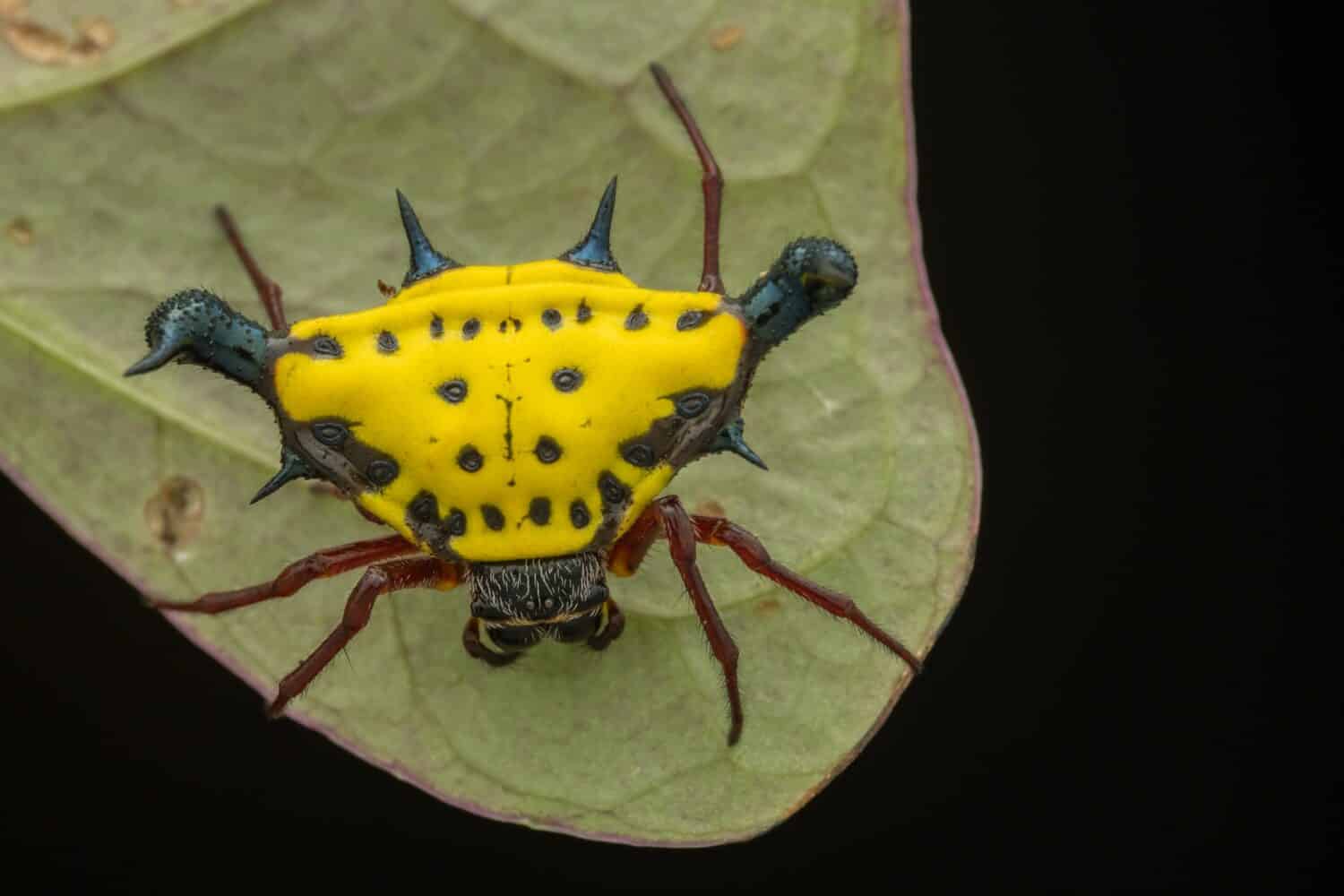
The yellow-backed spiny spider is a striking creature to see.
©Alen thien/Shutterstock.com
The exotic and striking yellow-backed spiny spider (Gasteracantha cancriformis) inhabits tropical areas worldwide, including North and South America, Asia, and Africa. These spiders are renowned for their detailed, stunning look, which includes spiky protrusions from their abdomen and a body that is brilliantly colored in yellow and black.
Often found in forests, yellow-backed spiny spiders can be found in the understory of trees and plants. They are avid hunters and catch insects in their strong webs, including flies, mosquitoes, and butterflies. These spiders have spiky protrusions that act as a barrier to prevent their prey from escaping, making them exceptionally good at capturing their food.
During mating season, the male spider will approach the female spider and begin drumming on her web to signal his intentions. If the female spider is receptive, she will allow the male spider to approach and mate. After mating, the female spider will lay eggs in a silk sac and guard them fiercely until the spiderlings hatch.
While the yellow-backed spiny spider is not considered dangerous to humans, its venom can cause mild irritation and swell at the bite site. However, these spiders are considered beneficial to their ecosystems, as they help control populations of harmful insects.
8. Spiny Orb-Weaver Spider

Spiny orb-weaver spiders inhabit tropical regions of the world.
©SIMON SHIM/Shutterstock.com
The spiny orb-weaver spider (Gasteracantha spp.) is an orb-weaving spider found in tropical regions worldwide. These spiders are known for their distinct appearance, which includes spiky protrusions extending from their abdomen and brightly colored bodies.
Spiny orb-weaver spiders are active hunters, constantly on the move and searching for their next meal. They use their strong webs to catch insects, including flies, beetles, and butterflies. These webs are typically found in forested areas, where the spiders create them between trees and shrubs.
As skilled hunters, spiny orb-weaver spiders can capture prey with ease.
9. Yellow-Banded Huntsman Spider

With a leg span reaching over five inches, huntsman spiders are not small.
©Niney Azman/Shutterstock.com
The Sparassidae spider family includes the yellow-banded huntsman spider (Heteropoda venatoria). All around the world, including Asia, Africa, and the Americas, tropical and subtropical climates are home to these spiders.
Yellow and brown bands on its legs and a hairy body give yellow-banded huntsman spiders their distinctive appearance. Moreover, with a leg span of up to 15 centimeters, they are rather huge. Despite their size, these spiders are not hazardous and do not exhibit human aggression.
Yellow-banded huntsman spiders actively investigate their surroundings for prey, as their name suggests. They also hunt largely at night because they are nocturnal. These spiders spend the day hiding in cracks and beneath rocks to fend off predators and save energy.
These spiders chase after their prey and use their speed and agility to capture them rather than relying on webs. Also, they have exceptional vision, making locating and following their prey easy.
10. Arrowhead Spider

The arrow-shaped abdomen is one of the most distinguishing features of arrowhead spiders.
©Rusty Dodson/Shutterstock.com
The arrowhead spider (Verrucosa arenata) is a small spider native to the United States. These spiders are known for their unique appearance, including a distinctive arrow-shaped abdomen pattern.
Arrowhead spiders are active hunters, constantly searching for prey in their environment. They are typically found in grasslands and meadows, where they construct small webs close to the ground to catch their prey. As skilled hunters, arrowhead spiders can capture a variety of insects, including grasshoppers and crickets.
During mating season, the male spider will approach the female spider and engage in a courtship display. If the female spider is receptive, she will allow the male to mate. The female then lays her eggs in a small silken cocoon, which she guards until the spiderlings hatch.
They play an important role in their ecosystem by controlling insect populations, which can significantly impact the surrounding vegetation.
11. Black and Yellow Argiope Spider

Another name for black and yellow Argiope spiders is the yellow garden spider.
©iStock.com/DianaLynne
North America is home to a particular kind of spider known as the black and yellow Argiope spider. They have an amazing black and yellow coloring that may serve as a deterrent to predators.
These spiders weave incredibly complex webs to trap their prey and are extremely skilled predators. They frequently inhabit open spaces like fields or gardens since they may catch a lot of flying insects there.
Argiope spiders have a rather unique approach to mating. The male spider will put on a show to impress the female during mating season. They will mate, and the female will place her eggs in a tiny sac if she likes what she sees.
Although Argiope spiders are not harmful to people, their venom can occasionally result in minor side problems like swelling or redness. If they don’t feel threatened, they normally don’t bite.
12. Black and Yellow Crab Spider

are also called goldenrod crab spiders, and they can be all yellow.
©Tobias Hauke/Shutterstock.com
The black and yellow crab spider (Misumena vatia) is a fascinating little critter found in North America’s gardens and other green spaces. This spider is hard to miss with its vibrant black and yellow coloration.
Crab spiders are ambush predators, meaning they wait for their prey to come to them rather than actively hunting. They have a cool way of doing this: they sit on flowers and other vegetation and blend in with their surroundings, waiting for an unsuspecting insect to come along. Once their prey is close enough, the crab spider will strike.
One of the coolest things about the black and yellow crab spider is that it can change color to blend in with its surroundings. This is called “background matching,” allowing the spider to become nearly invisible to its prey. So not only are these spiders fierce predators, but they’re also masters of disguise!
If you’re lucky enough to spot a black and yellow crab spider in the wild, don’t worry – they’re not dangerous to humans. They’re quite beneficial because they help keep the insect population in check.
13. Black and Yellow Wolf Spider
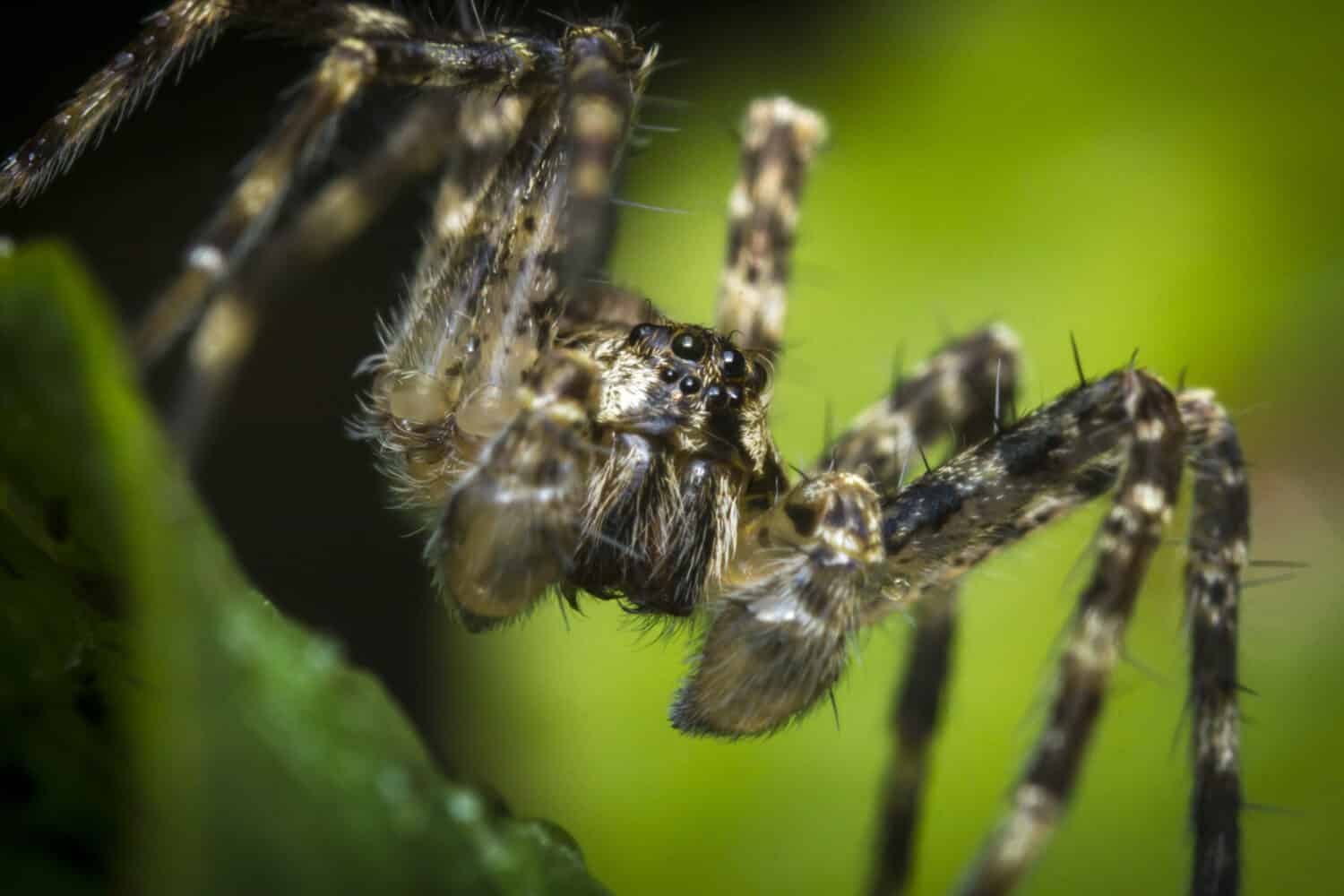
Wolf spiders are fearless, opting to hunt their prey rather than trap it in a web.
©Ezume Images/Shutterstock.com
The black and yellow wolf spider (Hogna carolinensis) is a bold and fearless hunter found in various habitats throughout North America. With its striking black and yellow coloration, this spider is one of the most eye-catching species in the wolf spider family.
Wolf spiders are active hunters that don’t rely on webs to catch their prey. Instead, they chase after their victims, pouncing on them lightning-fastly. Black and yellow wolf spiders are skilled at using their keen eyesight and powerful legs to take down even the most agile insects.
One of the most interesting things about the black and yellow wolf spiders is that they are quite social creatures. They often live in communal burrows with other wolf spiders, sharing resources and working together to raise their young. This is rare in the spider world, where most species are solitary.
Despite their intimidating appearance, black and yellow wolf spiders are not dangerous to humans.
Summary Of 13 Yellow And Black Spiders
| Name | Web Weaver or Hunter | Hazard Level of Bite |
|---|---|---|
| Golden Orb-Weaver Spider | Orb weaver | No hazard |
| Black and Yellow Garden Spider | Orb weaver | Mild pain and swelling |
| Yellow Sac Spider | Sac-like webs | Pain, redness, swelling and possibly more symptoms |
| Banded Garden Spider | Orb weaver | No hazard |
| Northern Yellow Sac Spiders | Makes sac and hunts | Mild pain, redness, and swelling |
| Orchard Orb-Weaver Spider | Not-sticky web and sticky web | Mild discomfort and swelling |
| Yellow-Backed Spiny Spider | Web and egg sac | Mild discomfort and swelling |
| Spiny Orb-Weaver Spider | Orb weaver | No hazard |
| Yellow-Banded Huntsman Spider | Active hunter | No hazard |
| Arrowhead Spider | Active hunter | No hazard |
| Black and Yellow Argiope Spider | Complex web | Mild swelling or redness |
| Black and Yellow Crab Spider | Ambush predator | No hazard |
| Black and Yellow Wolf Spider | Active hunter | No hazard |
The photo featured at the top of this post is © Karthik Nayak Virajpet/Shutterstock.com
Thank you for reading! Have some feedback for us? Contact the AZ Animals editorial team.






